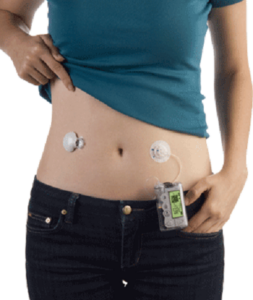Continuous Glucose Monitoring (CGM)

Without diabetes, your body tracks glucose levels all day and night to ensure the right amount of insulin is released at the right time. To successfully manage diabetes, a monitoring system is needed to consistently check your glucose levels. The most common glucose monitoring solutions are blood glucose meters and continuous glucose monitoring (CGM) systems.
The providers at Alpharetta and Cumming Internal Medicine can help you learn to maintain your diabetes with continuous glucose monitoring to get a more complete picture of your glucose levels, which can lead to better treatment decisions and better glucose control.
Candidates for CGM
CGM can be used by type 1 and type 2 diabetes patients who would like better glucose control to improve the health and quality of their lives. CGM is especially beneficial for people who:
- Want to reduce their A1C targets without increasing hypoglycemic events (low blood glucose).
- Have frequent low glucose levels or are unaware of their low blood sugars.
- Are pregnant or thinking about becoming pregnant.
- Are children and adolescents at or above their target A1C if they are willing to use the device every day.
Benefits of CGM
A blood glucose meter only provides a brief “snapshot” of your glucose level at a single moment in time. A CGM device, though, gives you a greater view of your glucose trends. CGM provides you with:
- Glucose levels every 5 minutes, 24 hours a day for 5 consecutive days.
- Real-time glucose data along with trends and the ability to see alerts
- Fingersticks are required to calibrate the glucose sensor and before making treatment decisions.
- Early notification of oncoming lows and highs.
- Alerts for lows or highs while you are sleeping or anytime.
- Insights into how food, physical activity, medication, and illness impact your diabetes.
CGM can provide valuable information at crucial points during the day, including before and during exercise, prior to driving, before test/exam-taking, and in the middle of the night. It is still required to check blood glucose levels with a fingerstick before therapy adjustment.
It is recommended that you calibrate CGM systems with fingersticks 3–4 times per day for optimal glucose sensor accuracy. CGM does require at least 1 fingerstick blood glucose reading every 12 hours to calibrate the CGM sensor.
About the CGM System
CGM is a way to measure glucose levels in real-time throughout the day and night. A tiny electrode called a glucose sensor is inserted under the skin to measure glucose levels in tissue fluid. It is connected to a transmitter that sends the information via wireless radio frequency to a monitoring and display device. The device can detect and notify you if your glucose is reaching a high or low limit. The latest CGM systems can actually alert you before you reach your glucose limits.
Call to Schedule an Appointment
Alpharetta Internal Medicine Office
1380 Upper Hembree Rd.
Roswell, GA 30076
Cumming Internal Medicine Office
950 Sanders Rd
Cumming, GA 30041

